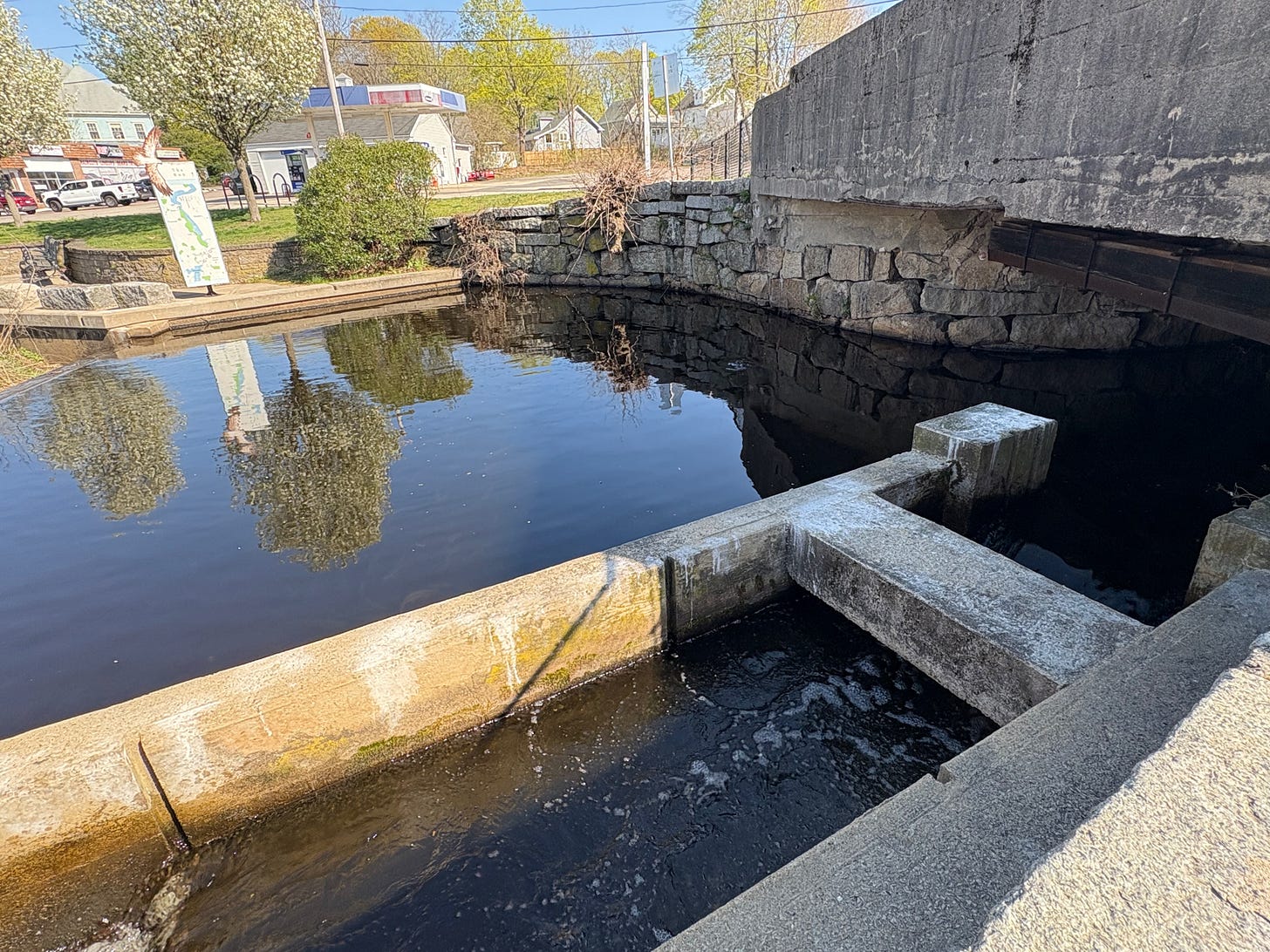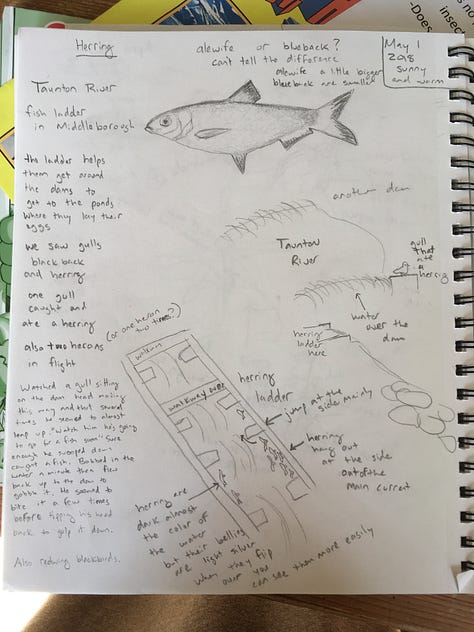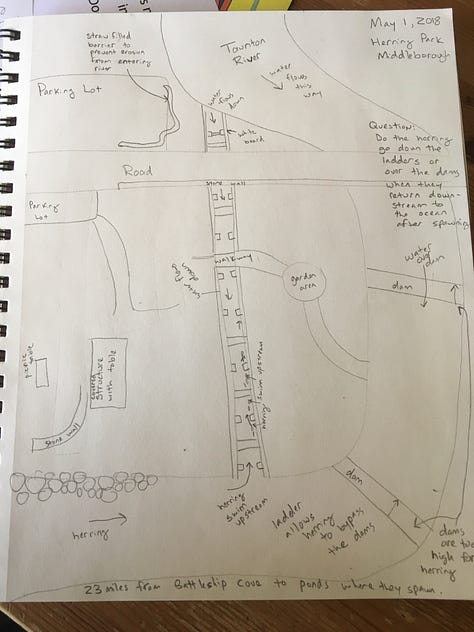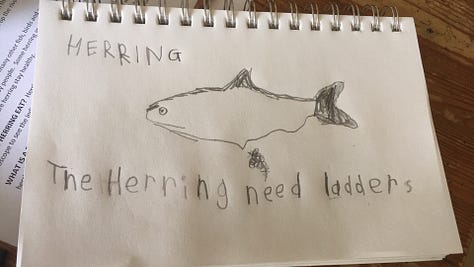silver light-splashers thrashing against the current yearning towards home
After our hike at World’s End we stopped at a herring ladder on our way home. The herring swim from the sea up streams and creeks to ponds where they lay their eggs and a new generation begins. People realized that in order to protect the herring from extinction they needed to make sure the streams, which had often been dammed, were navigable to the fish, so they constructed these ladders, a series of connected pools, which the fish climb, swimming against the fiercely flowing current.
I think the first time we went to see the herring run was ten years ago. I was a young homeschooling mom and I’d just connected with a local homeschooling group. We met up at the Cape Cod Canal and a park ranger taught us about the herring and we visited the herring ladder and she netted some of the fish for us so we could see them up close. Then there were some games where the children pretended to be herring and tried to dart past various predators, learning that there is greater safety in numbers.
We’ve gone back to the Canal one other time for the herring tour, and once we joined the homeschooling group at a different location where we helped in the official counting. Since then we’ve also discovered some herring ladders nearer home. While we don’t make it to visit the herring every year, it’s still a cherished family tradition to go and watch these small silver fish swimming and thrashing upstream to reach the ponds where they spawn. It makes us feel connected to our particular place, the history of it, the conservation of its unique particularities.
Here’s one of several videos I took of the herring swimming up the ladder. I don’t know about you, but I find it soothing and mesmerizing to listen to the sound of the running water, to watch its flow, and to be constantly surprised by the flashing fish. When we are sitting next to the herring ladder it feels almost obligatory to cheer on each fish as it flashes past.
This particular herring run is in Weymouth, in the middle of an urban area. According to the North and South Rivers Watershed Association:
“. . . this unlikely urban pocket park holds one of the most vigorous herring runs on the South Shore, with an estimated population of over 500,000 spawning fish! The run links Weymouth’s Back River to Whitman’s Pond and has been monitored and cared for by Herring Wardens George Loring and Phil Lofgren for decades. The herring run here is largely an alewife run, which prefer to spawn in ponds rather than a blueback herring run, which prefer to spawn in flowing water. Because the alewives’ cue to return is water temperature about 50 degrees, your best bet to see these fish is before the end of April.”
This is the second of five ladders the herring must climb on their journey from the Atlantic Ocean to Whitman’s pond. A description of the whole water system can be found on the Backriver Watershed page.

When we left the house it had not crossed our mind that it was herring season; but as we passed by the ladder my birdwatcher noticed the collection of gulls perched on the roofs of nearby buildings and whirling overhead and that was our signal that the herring are running. So on our way back home we stopped and sat down on the side of the ladder to watch the annual migration of determined fish flinging themselves upstream again and again, flashing silver in the sunlight.
There are two species of herring in Massachusetts, but these are alewife herring. Which is a lovely name. I’m not sure if they’re called alewife because women who brew beer would serve it with herrings or because someone thought the fish’s rounded abdomen looked like that of a woman who brews beer— this second although it gets top billing, seems a bit unlikely to me. There probably isn’t a definitive answer, as with many etymologies. Nonetheless, the alewife herring also gives its name to a station on Boston’s Red Line. For the longest time I didn’t know that an alewife was a type of fish and I thought it was the oddest name for a stop. (The other end of the red line is at Braintree, which is another odd name. Like so many place names in Massachusetts, Braintree is originally English. It comes from the name of a town in Essex, England— and there are many etymological theories about that as well.)
Herring swirling about in the resting pond. Here they can recover after their swim up the ladder before continuing further upstream.



It’s a bit harder to see the fish in this video, but it gives a good idea of the power of the water they are swimming against.
The Herring Ladder and the Holy Spirit
Last year on the way home from Nantasket Beach we visited a different herring ladder— the first one on Jackson Square. After that trip I wrote the following reflection about the herring ladder and the Holy Spirit:
In the place where we stopped to watch the stream was divided in two. On the right side was the ladder with fish jumping from one pool to the next. Each pool had these little walls where the fish could shelter to rest a bit before attempting the next jump. Sometimes you'd see the fish going backwards, downstream, but usually they'd only go down one pool and they'd be able to rest and then try again. But on the left side there was no ladder, just the shallow and swiftly flowing stream with no place for the fish to rest. We watched as one fish after another tried so hard to make their way upstream on that left side, their tails thrashing so fast, like little motors-- until, exhausted, they gave up and floated back down, looking almost lifeless with their silver bellies showing. But the defeated fish ended up back in the pool at the bottom where they would have the chance to go to the right and climb the ladder up to the top.
I've been thinking a lot about that image of those fish swimming upstream and falling back exhausted and half-connecting it to the image of the Holy Spirit as a life-giving fountain of living water1 and wondering how the juxtaposition of the two images might illuminate some aspect of the spiritual life. I'm not quite sure how to put it all together. But I'm thinking of how the Spirit gives us life and grace and all we need; but sometimes it feels like I'm swimming upstream and so exhausted, so defeated.
Maybe the Spirit also gives us resting places where we can just pause, rest, recuperate before we turn upstream to fight again against the current. Maybe the Spirit even has to sometimes steer us away from unproductive paths, and prevent us from throwing ourselves uselessly at life, doing it the hard way. And if we would only give up and admit defeat, he could lead us to an easier path, to the ladder that is still difficult, but where there are the resting places we need, the pools where he gives us rest to strengthen us for the journey.
Anyway, that's where St Cyril and the Holy Spirit are bringing me today.
from St Cyril of Jerusalem (taken from the Office of Readings):
*The water I shall give him will become in him a fountain of living water, welling up into eternal life*. This is a new kind of water, a living, leaping water, welling up for those who are worthy. But why did Christ call the grace of the Spirit water? Because all things are dependent on water; plants and animals have their origin in water. Water comes down from heaven as rain, and although it is always the same in itself, it produces many different effects, one in the palm tree, another in the vine, and so on throughout the whole of creation. It does not come down, now as one thing, now as another, but while remaining essentially the same, it adapts itself to the needs of every creature that receives it.
In the same way the Holy Spirit, whose nature is always the same, simple and indivisible, apportions grace to each man as he wills. Like a dry tree which puts forth shoots when watered, the soul bears the fruit of holiness when repentance has made it worthy of receiving the Holy Spirit. Although the Spirit never changes, the effects of his action, by the will of God and in the name of Christ, are both many and marvellous.
The Spirit makes one man a teacher of divine truth, inspires another to prophesy, gives another the power of casting out devils, enables another to interpret holy Scripture. The Spirit strengthens one man’s self-control, shows another how to help the poor, teaches another to fast and lead a life of asceticism, makes another oblivious to the needs of the body, trains another for martyrdom. His action is different in different people, but the Spirit himself is always the same. In each person, Scripture says, the Spirit reveals his presence in a particular way for the common good.
The Spirit comes gently and makes himself known by his fragrance. He is not felt as a burden, for he is light, very light. Rays of light and knowledge stream before him as he approaches. The Spirit comes with the tenderness of a true friend and protector to save, to heal, to teach, to counsel, to strengthen, to console. The Spirit comes to enlighten the mind first of the one who receives him, and then, through him, the minds of others as well.
As light strikes the eyes of a man who comes out of darkness into the sunshine and enables him to see clearly things he could not discern before, so light floods the soul of the man counted worthy of receiving the Holy Spirit and enables him to see things beyond the range of human vision, things hitherto undreamed of."







Your daughter's wonderful photograph looks for all the world like a painting, Melanie! And I love the line "silver light-splashers".
Interesting to see the herring going against the current and jump and swim through. That's great that there is a ladder system for the herring to make their way back from the ocean to their freshwater spawning ground. Thanks for sharing, Melanie and a perfect haiku as well!